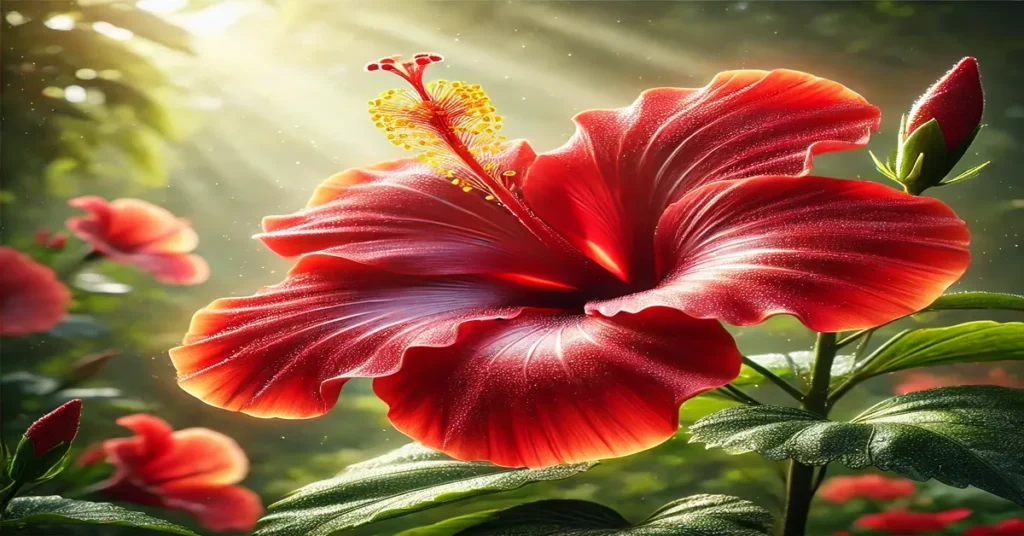The hibiscus flower is a vibrant and captivating bloom that holds a unique place in the world of flora. Known for its large, trumpet-shaped flowers and vivid colors, the hibiscus is not only a feast for the eyes but also a treasure trove of cultural, medicinal, and ecological significance. This article delves into the multifaceted aspects of the hibiscus flower, exploring its origin, varieties, uses, and much more.
Introduction to Hibiscus
The hibiscus is a genus of flowering plants in the mallow family, Malvaceae. With over 300 species, the hibiscus is native to warm, temperate, subtropical, and tropical regions of the world. Its scientific name, Hibiscus rosa-sinensis, reflects the species commonly cultivated as an ornamental plant. However, the hibiscus family includes a wide range of species with varying characteristics and applications.
1. Characteristics of the Hibiscus Flower
Hibiscus flowers are characterized by their striking appearance and distinctive structure. Below are some key attributes:
A. Physical Appearance
- Size: Hibiscus flowers can range from small, 2-inch blooms to large flowers spanning up to 10 inches in diameter.
- Shape: The flowers are typically trumpet-shaped with five or more petals.
- Color: They exhibit a spectrum of colors, including red, pink, yellow, white, orange, and purple. Some species even display multicolored patterns.
- Leaves: Hibiscus plants have glossy, green leaves with serrated edges.
B. Growth Habit
Hibiscus plants can grow as shrubs, trees, or herbaceous perennials, depending on the species. They thrive in warm climates and are often found in gardens, landscapes, and pots.
C. Pollination
The hibiscus flower is a favorite among pollinators such as bees, butterflies, and hummingbirds, thanks to its bright colors and nectar.
2. Origin and Distribution
The hibiscus plant traces its origins to Asia, specifically India and China, before spreading to other parts of the world. Today, it is cultivated globally, with notable varieties adapted to local climates and conditions.
Key Regions of Cultivation
- Asia: Countries like India, China, and Thailand are significant producers.
- Africa: Species like Hibiscus sabdariffa are grown extensively.
- Caribbean and Pacific Islands: Hibiscus is deeply embedded in the cultural and ecological landscape of these regions.
- United States: Florida, Texas, and Hawaii are leading states in hibiscus cultivation.
3. Popular Varieties of Hibiscus
Hibiscus encompasses an impressive range of species, each with its unique characteristics. Some popular varieties include:
A. Tropical Hibiscus (Hibiscus rosa-sinensis)
Known for its vibrant, glossy flowers, this species is commonly grown as an ornamental plant.
B. Hardy Hibiscus (Hibiscus moscheutos)
Adapted to cooler climates, this variety produces large, showy blooms.
C. Roselle (Hibiscus sabdariffa)
Primarily cultivated for its calyces, which are used to make hibiscus tea and other products.
D. Confederate Rose (Hibiscus mutabilis)
Famous for its changing flower colors, which transition from white to pink to red over a single day.
4. Cultural Significance
The hibiscus flower is deeply woven into the cultural fabric of many societies.
A. Symbolism
- Hawaii: Known as “pua aloalo,” the hibiscus is the state flower and symbolizes hospitality and joy.
- India: Associated with the goddess Kali, the red hibiscus is often used in Hindu rituals.
- China: The flower represents fame and personal glory.
B. Art and Fashion
Hibiscus motifs are common in textiles, paintings, and jewelry, particularly in tropical cultures.
C. Festivals and Traditions
In the Pacific Islands, hibiscus flowers are worn behind the ear to indicate marital status—left for married and right for single individuals.
5. Medicinal and Health Benefits
The hibiscus plant is renowned for its health-enhancing properties, with applications in traditional and modern medicine.
A. Hibiscus Tea
Made from the dried calyces of Hibiscus sabdariffa, this tart, ruby-red beverage is rich in antioxidants and offers numerous health benefits:
- Lowering Blood Pressure: Studies suggest that hibiscus tea may reduce systolic and diastolic blood pressure.
- Aiding Weight Loss: The tea is believed to help manage body weight by reducing fat absorption.
- Improving Digestion: Its diuretic properties help cleanse the kidneys and bladder.
B. Herbal Remedies
- Skin Care: Hibiscus is a natural source of alpha-hydroxy acids (AHAs), which promote healthy skin.
- Hair Care: Hibiscus extracts are often used in oils and shampoos to promote hair growth and combat dandruff.
- Anti-Inflammatory Properties: Hibiscus leaves and flowers are used in poultices to reduce swelling and pain.
6. Ecological Importance
The hibiscus flower plays a crucial role in maintaining ecological balance:
- Pollination: Attracts essential pollinators like bees and butterflies.
- Soil Erosion Control: The plant’s robust root system helps prevent soil erosion.
- Habitat Creation: Provides shelter for small animals and insects.
7. Growing and Caring for Hibiscus
Growing hibiscus plants is relatively straightforward with proper care and attention.
A. Soil and Climate
- Soil: Prefers well-draining, slightly acidic to neutral soil.
- Climate: Thrives in warm and sunny environments.
B. Watering and Fertilization
- Watering: Requires regular watering but should not be overwatered.
- Fertilizer: High-potassium fertilizers encourage blooming.
C. Pruning and Maintenance
- Regular pruning helps maintain the plant’s shape and encourages new growth.
- Inspect for pests like aphids and whiteflies.
D. Propagation
Hibiscus can be propagated through seeds, cuttings, or layering.
8. Commercial Applications
Hibiscus has a wide array of commercial uses:
- Food Industry: Used in teas, jams, and syrups.
- Cosmetics: Incorporated into skincare and haircare products.
- Textiles: The plant’s fibers are used in making ropes and mats.
9. Challenges and Threats
Despite its popularity, hibiscus faces several challenges:
- Pests and Diseases: Aphids, mealybugs, and fungal infections can harm the plant.
- Climate Change: Rising temperatures and erratic weather patterns threaten its natural habitats.
- Overharvesting: Excessive harvesting of wild species can lead to population decline.
10. Future Prospects
With growing interest in sustainable practices, the hibiscus plant is poised for greater utilization in herbal medicine, cosmetics, and agriculture. Its adaptability and multifaceted uses make it a valuable plant for future research and development.
Conclusion
The hibiscus flower, with its stunning beauty and diverse applications, stands as a testament to the wonders of nature. From its cultural significance to its medicinal properties, this plant has touched the lives of people across the globe in countless ways. By understanding and appreciating the hibiscus, we can ensure its continued presence and benefits for generations to come.
FAQs About Hibiscus
1. What are the main types of hibiscus?
The main types of hibiscus include tropical hibiscus (Hibiscus rosa-sinensis), hardy hibiscus (Hibiscus moscheutos), roselle (Hibiscus sabdariffa), and confederate rose (Hibiscus mutabilis).
2. Can hibiscus grow indoors?
Yes, hibiscus can grow indoors, provided it receives ample sunlight and is kept in well-draining soil. Regular watering and occasional fertilization are also essential.
3. How is hibiscus tea made?
Hibiscus tea is made by steeping dried hibiscus calyces in hot water. It can be enjoyed hot or cold, often with added sweeteners like honey.
4. Are there any side effects of consuming hibiscus?
While generally safe, excessive consumption of hibiscus may cause a drop in blood pressure or interact with certain medications. Pregnant and breastfeeding women should consult a healthcare provider before use.
5. Why do hibiscus flowers only bloom for one day?
Many hibiscus species bloom for a single day due to their natural lifecycle, where the flower opens in the morning and wilts by evening. However, the plant produces blooms continuously during its flowering season.
6. What pests commonly affect hibiscus plants?
Common pests include aphids, whiteflies, and spider mites. Regular monitoring and natural remedies like neem oil can help manage infestations.







